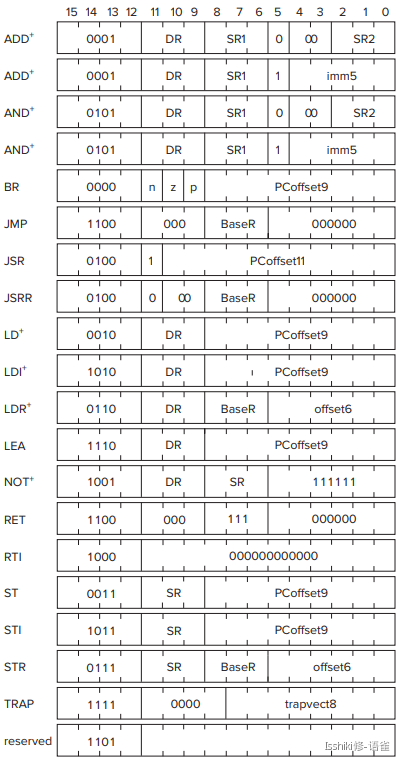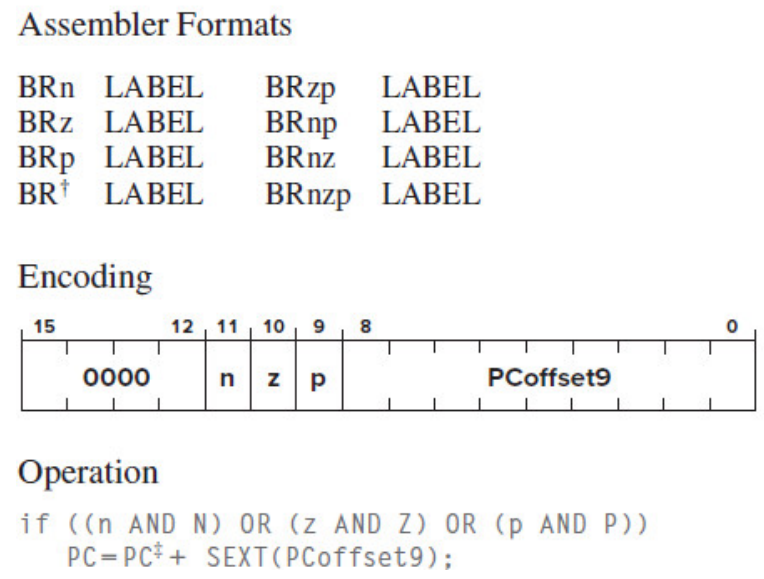ICS Chapter 4 and Chapter 5
https://www.yuque.com/isshikixiu/codes/ics#xLzvZ
Chapter 4
von Neumann machine
-
Input: input data to the machine
-
Output: display the results
-
Memory: stores data
-
Processing Unit: processes infomation and do calculations
-
Control Unit: controls the execution of computer program
LC-3
The LC-3 memory has an address space of 2 16 (i.e., 65,536) locations, and an addressability of 16 bits
- ALU: 一次处理的二进制串长度称为word, LC3为16,一般为32/64
- MEMORY consists of the storage elements, along with the MAR for addressing individual locations and the MDR for holding the contents of a memory location on its way to/from the storage
- The IR (instruction register) is also an input to the finite state machine since the LC-3 instruction being processed determines what activities must be carried out.
- The PC (program counter) is also a part of the control unit; it keeps track of the next instruction to be executed after the current instruction finishes.
- 8 general purpose register (GPR) R0-R7
指令执行的六个阶段(4.3.2)
- FETCH
- MAR ←PC
- 访问内存,结果放入MDR
- IR ←MDR
- Decode
- Evaluate Address
- Fetch operands 用到MAR,MDR
- Execute
- Store Resu
Data Path
附录C.3 或PPT
实验课相关 LC3TOOLS
注意调试时如果Randomize Machine,要Reload object files,否则内存中指令的位置会被覆盖
LC-3 ISA
 附录A
附录A
程序开头指定第一条指令在内存中存储的位置x3
PC寄存器:存储下一条指令在内存中存储的地址。每执行一步则+1
Addressing Modes
- PC-relative
PC'=PC+offset比如LD,BR,JMP - Indirect 比如LDI,STI
- baseR+offset: LDR,STR
后面两种都可以了解决offset长度不够的问题,因为offset一般是9位,而地址可以到16位
baseR+offset可以做数组的寻址,baseR就是数组首地址
ADD,AND,NOT
注意Imm5范围是[-16,15]
LD,LDI,LDR
汇编
- LD DR,LABEL (汇编器会自动计算PCoffset,但如果距离太远就会报错) DR=mem[LABEL]
-
LDI DR,LABELDR=mem[mem[LABEL]](可以实现任意地址的跳转) -
LDR DR,BaseR,LABELDR=mem[BaseR+LABEL]
二进制:

DR:目标寄存器(000-111), PCoffset9是PC中的地址到内存中想要的数据地址的偏移量
意思是DR=mem[PC+PCoffset9]
LEA
It does not really operate on data, it simply loads a register with an address.
DR=PC+offset
BR
见5.4.1
除了8个GPR之外,还有三个寄存器N,Z,P. 每次写入GPR时(通过ADD,AND,NOT,LD,LDR,LDI,没有LEA),计算机会设置N,Z,P.
- N代表写入的数<0 Z代表=0, P代表>0 如写入5,那么N,Z,P分别是0,0,1
BR操作指定n,z,p, 表示需要判断哪些寄存器为1
注意n,z,p是程序的指令,是不变的。N,Z,P是寄存器的值(condition code),在运行中会变,且每个时刻N,Z,P有且仅有一个是1

举例: 计算\(R3=R1\times R2\)的机器码 (循环,每次R2-=1,R3+=R1)
0011 0000 0000 0000 ;.ORIG x3000
0101 011 011 1 00000 ;AND R3,R3,0 R3=0
0010 001 000000100 ;LD R1,
0010 010 000000100 ;LD R2,
0001 011 011 0 00 001; R3=R3+R1
0001 010 010 1 11111 ;R2=R2+(-1)
0000 101 111111101 ; if R2>0 or R2<0 then PC=PC-3(回到R3=R2+R1)
注意最后BR的指令是101,这是为了处理乘以负数的情况 如果用001,当R2是负数的时候就直接退出了
为什么R2是负数的时候不断-1,结果还是正确的??
注意汇编器的BR等价于BRnzp,即无条件跳转
0000 000 000000000代表什么都不做,执行下一条
0000 111 000000001代表跳过BR后面的一条指令
LC-Assembly
Labels
symbolic names that are used to identify memory locations that are referred to explicitly in the program (不需要像机器码那样手算)
实际上就是一个地址
-
存值
LD R1,ALPHAST R1,SUM -
分支
BRp LOOP(汇编器会自动计算offset)
Offset有符号
Assembler Directives
(pseudo-ops):
.ORIG ADDRESS: 指定起始地址。和.END配对
.END: 告诉汇编器结束
LABEL .FILL VALUE: set some place in the memory to VALUE, and can be loaded using LABEL. etc. LD R1,LABEL will set R1=mem[VALUE]
这种情况下LABEL相当于指向VALUE的"指针"
LD R1,x不是赋值,而是把R1设成mem[x](类似于C语言中的*运算符),如果要把R1设成x,可以先置0再ADD R1,R1,x
此时执行LD R0,LABEL得到的是数组第一个元素的值(0). 要想得到地址,必须ADDR .FILL LABEL 然后LD R0,ADDR
读取指定地址的内容 (这样可以读取任意地址的内容,而LD,LDR受offset长度限制,不能跳的太远) ADDR是直接附在代码最后的,距离调用时的PC不会太远
LABEL .BLKW N 分配N个word(在LC-3是16-bit)的连续内存,指向内存的第一个元素
LABEL .STRINGZ "abcd" 分配len+1个word,每个word存一个字符,末尾0,指向第一个字符
The Assembly Process
2-PASS
- pass 1: construct symbol table(each LABEL, find memory address) 计算内存地址的时候,记得每条指令本身占一个地址
- 注意.ORIG第一行不算
- 注意写成16进制,不要写成10进制
- pass2: translate
.ORIG x8003
AND R1,R1,#0
ADD R0 ,R1,#5
ST R1,B
LD R1,A
BRz SKIP
ST R0,B
SKIP TRAP x25
A .BLKW #7
B .FILL #5
BANNER .STRINGZ "we are done ! "
C .FILL x0
.END